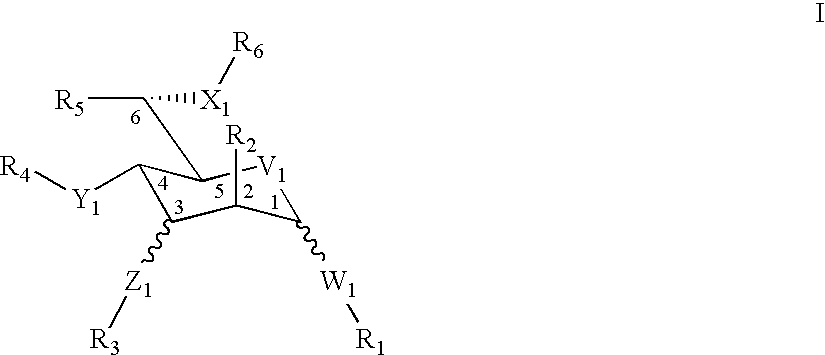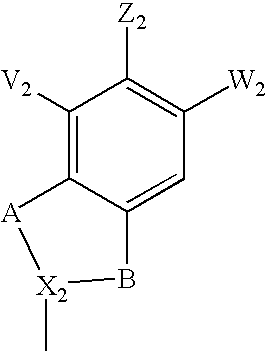Treatment or prophylaxis of diseases caused by pilus-forming bacteria
- Summary
- Abstract
- Description
- Claims
- Application Information
AI Technical Summary
Benefits of technology
Problems solved by technology
Method used
Image
Examples
example 2
Binding Between PapD and the Carboxyl Terminus of Other Pap Peptides
[0357]G1′-19′WT, E1′-19′WT, F1′-19′WT, K1′-19′WT and H1′-19′WT peptides (see table 1) were synthesized corresponding to the 19 carboxyl terminal residues of P pilus subunit proteins PapG, PapE, PapF, PapK and PapH, respectively (see: Grant et al., 1992, and references cited therein).
[0358]
TABLE 1NameSEQ ID NO:Peptide sequenceG1′-19′WT6NH2-GKRKPGELSGSMTMVLSFP-COOHG1′-16′WT7NH2-KFGELSGSMTMVLSFP-COOHG1′-11′WT*8NH2-SGSMTMVLSFP-COOHG1′-7′WT9NH2-TMVLSFP-COOHG1′-19′SV10NH2-GKRKPVELSGSMTMVLSSP-COOHG1′-19′amide11NH2-GKRKPGELSGSMTMVLSFP-CONH2G2′-21′amide12NH2-EEGKRKPGELSGSMTMVLSF-CONH2E1′-19′WT*13NH2-QNLIAGPFSATATLVASYS-COOHH1′-19′WT14NH2-KKLEAGNYFAVLGFRVDYE-COOHK1′-19′WT15NH2-KSVVPGDYEATATFELTYR COOHF1′-19′WT16NH2-GILNGGDFQTTASMAMIYN-COOHMS17NH2-YALAPNAVIPTSLALL-COOH* Water insoluble peptides
[0359]The residues in the peptides were numbered starting with the carboxyl terminal residue as 1, and ending with the amino terminal ...
example 3
Designing of Compounds Capable of Binding to the Binding Site of PapD
[0385]Having determined the location of a promising binding site for inhibitory ligands as described in Examples 1 and 2, the computer programs ′PLIM′ and ′PLIM_DBS′ (developed by Symbicom AB) were used to find templates for families of compounds capable of binding to the binding site (see the general description above).
[0386]PLIM was run on a 20 Å box around the Arg-8 region of the high-resolution structure of PapD, searching for low-energy binding positions for NH, NH2, O, OH and C probes. The PLIM runs resulted in a number of suggested positions and orientations of favourable chemical groups (site points) in the region near Arg-8 and Lys-112.
[0387]Approximately 50 sites were identified, and then triplets and quartets of these site points were selected for their mutual compatibility, that is to say they must have appropriate geometric relationships—distances and orientations that could be found in a real molecule...
example 4
Synthesis of Compounds of the hdo Family Capable of Binding to the Binding Site of PapD
General Methods
[0415]1H- and 13C-NMR spectra were recorded in CDCl3 at 300 and 75 MHz respectively on a Varian Gemini 300 spectrometer unless otherwise stated. Signals from undeuterated solvent at 7.25 and 77.0 ppm respectively were used as internal reference signals. Optical rotations were measured using a Perkin Elmer 241 polarimeter.
[0416]Thin layer chromatography was performed on Merck DC-Fertig-platten (Kiselgel 60 F254 0.25 mm) and spots visualized by spraying with 10% sulphuric acid followed by charring at elevated temperature and / or spraying with molybdatophosphoric acid hydrate / Ce(SO4)2 / dil. H2SO4 followed by heating (molybdatophosphoric acid hydrate=H3[P(Mo3O10)4]×H2O, E.Merck, Darmstadt, Germany).
Ethyl 2,3-O-dibenzoyl-4-O-benzyl-1-thio-μ-D-glucohexopyranoside
[0417]Ethyl 2,3-O-dibenzoyl-4,6-O-benzylidene-1-thio-β-D-glucohexo-pyranoside (150 mg, 0.29 mmol) was dissolved together with bora...
PUM
| Property | Measurement | Unit |
|---|---|---|
| Fraction | aaaaa | aaaaa |
| Fraction | aaaaa | aaaaa |
| Fraction | aaaaa | aaaaa |
Abstract
Description
Claims
Application Information
 Login to View More
Login to View More - R&D
- Intellectual Property
- Life Sciences
- Materials
- Tech Scout
- Unparalleled Data Quality
- Higher Quality Content
- 60% Fewer Hallucinations
Browse by: Latest US Patents, China's latest patents, Technical Efficacy Thesaurus, Application Domain, Technology Topic, Popular Technical Reports.
© 2025 PatSnap. All rights reserved.Legal|Privacy policy|Modern Slavery Act Transparency Statement|Sitemap|About US| Contact US: help@patsnap.com



